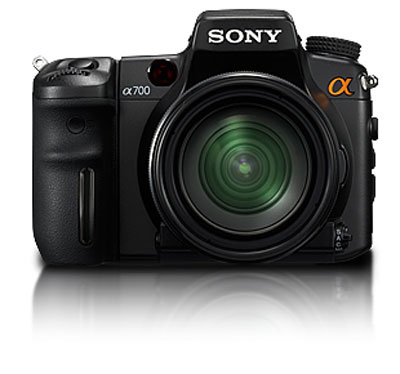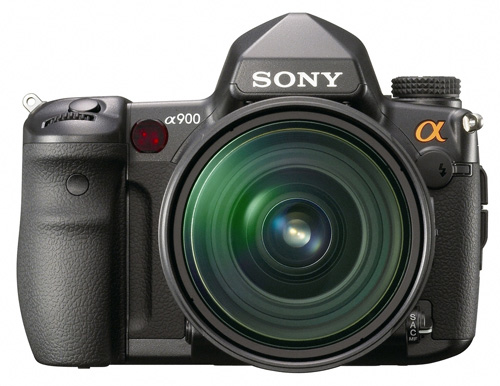Sony A900 Full-Frame: Hands-On Preview
by Wesley Fink on September 12, 2008 12:00 AM EST- Posted in
- Digital Camera
When Sony purchased Konica-Minolta in January of 2006, everyone expected the world's largest digital sensor manufacturer to use the Minolta acquisition to boomerang Sony's entry into the DSLR market. It was soon clear that Sony had ambitious plans for capturing market share in photography's fastest growing market, but the going has been slow.

In the past year Sony has kicked up the pace, beginning with the A700 to compete in prosumer space, followed quickly by the A200 entry-level DSLR, and the A350/A300 DSLRs built with a truly unique and useful Sony implementation of Live View. The Sony Live View is the only Live View that truly behaves like a point and shoot camera in Live View mode. It's as simple as a switch that lets a new user move between Live View and traditional DSLR.
The culmination of the Sony push into the Digital SLR market was unveiled on September 8, after 18 months of hints, speculation, and closed case exhibits at photography events. It is likely that anyone out there who follows photography has at least heard of the A900 - Sony's flagship DSLR and the first to showcase the new Sony 24.6MP full-frame sensor. It also gives the full-frame resolution crown to Sony for the time being, as no other full-frame sensor can claim resolution this high. The closest competitor is the $8000 Canon 1Ds Mark III at 21.1MP.

Sony launched the new A900 in events around the world where invited press and professional photographers were given the opportunity for hands-on time with the A900. It was certainly a controlled environment, with a studio setup with a model and a typical tethered studio shooting product ads. The two environments do reflect how most photographers make their living today, but the manufacturer setups are hardly designed for a competitive comparison. That will have to wait until production cameras arrive in November.
Today we are publishing the A900/Sony DSLR press announcements. You may have already seen the A900 announcement, but we have gathered information on the Sony flagship items together so you can more easily see how the parts contribute to the whole. There was not enough hands-on time to do anything like a thorough analysis of a groundbreaking new camera like the A900. That will have to wait until the release of the A900 in November. However, strong impressions were triggered and we did have enough time with the A900 system to answer many of our questions about the feel, layout, and controls of the new A900. Those impressions are shared on pages seven and eight in our complaints and praise for the new Sony A900.










53 Comments
View All Comments
chiew - Sunday, September 14, 2008 - link
If all you want is 24mp...Nikon's D700 is priced equivalently, doesn't have the 24mp...but it has more ISO range and a pro AF system. I don't see why you're crying.
Lord 666 - Friday, September 12, 2008 - link
More than likely same MP in sensor, but same or better outstanding ISO performance as D3.I've never held a Sony DSLR yet, but question the build quality. Additionally, I find it interesting that when other camera companies market their cameras, they almost always exclusively show the pics taken with them, but no cameras inside those pictures as subjects. Sony on the other hand releases pictures "in the wild" of people using the camera almost as models. Check out http://www.dailytech.com/article.aspx?newsid=12902">http://www.dailytech.com/article.aspx?newsid=12902
Wesley Fink - Friday, September 12, 2008 - link
Sony announced the A900 with both studio setups surrounded with 2x3 feet enlargements of images taken with the A900. The brochure for the A900 is around 8x12" and filled with double page photos(12x16 inches). Both studio setups were tethered to huge Bravia HD TVs. The photographers in both settings were shooting, displaying on screen and doing 6.5x zooms to show detail. A large number of A900 cameras were available for us to shoot both scenes.In the Sony A900 launch event the emphasis was clearly on images captured with the the A900. As for build quality you should examine an A900 to answer your questions about build quality. Feel and Build Quality certainly appear superb. I also own a D3 and D700 and the Sony A900 belongs in that league IMHO.
Lord 666 - Friday, September 12, 2008 - link
So you have finally come over to the Nikon side with those investments in the D3 and D700? Don't you also have/had a D300?Wesley Fink - Friday, September 12, 2008 - link
I sold my D300 and all my DX lenses when I went for the D3/D700, and I particularly like the size, capabilities. and value of the D700. I also own other cameras and have some lenses for every system we review since they are needed for testing.My main APS-C since the exit of the D300 is the Sony A700 which is the same sensor and LCD as the D300, but obviously not the same electronics/post processing as the Nikon. Sony has continued to improve their post-processing and finally have the option to turn off NR completely in RAW with firmware 4. JPEGs are also further improved in 4. THe A700 is very nice with the in-body IS that works with lenses like the Tamron 18-250mm (or Sony 18-250mm), which is a really terrific lens for when I need small and compact.
I am also testing a Sony A200 right now, which at less than $500 for camera with body IS and 18-70mm kit lens is looking like a heck of a buy.
davidaspart - Friday, September 12, 2008 - link
"Same Pricey Battery- The same proprietary NP-FM500H battery used in the A700, A350, A300, and A200 is also used in the A900. Great consistency, but you can still only buy it from Sony and you will still pay $55 to $95 for a spare. Sony insists on pimping their battery manufacturing even if their stubborn insistence on a proprietary battery drives some users away in a market where they need to win new users."Oh come on!
Thats like saying someone who buys a Ferrari worries that it takes premium fuel.
The camera costs $3000!
Koing - Friday, September 12, 2008 - link
Indeed. How much are OEM Canon cameras?If you drop $3000 on a camera and $500 on a flash $100 for a battery isn't a big deal...
The MS is a Sony thing...
Koing
Wesley Fink - Friday, September 12, 2008 - link
The less than $500 A200 kit uses the same battery as the A900, which is great consistency. Frankly so did the A100, but you could buy generic A100 batteries if you chose for less than $8. When Sony introduced the A700 they added a groove to the center of the battery so A100 batteries would no longer fit and apparently patent4ed the revised design. In fact A100 chargers still work just fine with the new Sony A700/A900/A350/A300/A200 battery.Many would definitely stick with the manufacturer's battery, but my complaint is about choice. I can choose which battery with Canon, Nikon, Pentax and Olympus batteries as generic options are readily available. You can not choose another battery with any of the new Sony cameras. Sony is a huge battery maker and they have locked up choice. You are forced to buy the Sony overpriced battery as there are no other choices in the market.
As an aside Sony STILL will not allow the use of AA batteries in their grips. Many like the versatility of using rechargeable AAs to power their grips instead and other companies include the AA insert or offer it as an option. There is also the issue of flexibility. If you get caught with a dead proprietary battery in the field it is reassuring to know you can continue shooting with AAs that are readily available anywhere - but that is not an option with Sony DSLR cameras.
KorruptioN - Friday, September 12, 2008 - link
I've mentioned this before - the battery incorporates InfoLithium technology which relays exact info in terms of a percentage remaining, instead of a graphic battery meter with five different levels. This feature is fantastic and is worth the money (to me).Serious question now, does Nikon's battery in the D300/D700/D3 relay that same percentage info even if you get a generic battery? I know that you have to dive deep into a menu to get that information.
Wesley Fink - Friday, September 12, 2008 - link
The D300/D700 use the same EN-EL3e battery as the D80, which does not provide a percentage. With optional accessories you can add the BL-4(a) high capcity battery to the MB-D10 battery grip and it does indeed report the percentage - at least when charging and on the D3. That battery though is 2500mAh and not the lower capacity 16500mAh of the Sony battery.Generics for the EN-EL3e used in the D700 and D300 generally perform the same and there are many with higher capacity and longer life. The EN-EL4(a) used in the D3 and D2x is tougher for finding generic replacements. Some I have seen do work but it is much more a question mark than the 3e and the generics generally don't report percent.
The Sony NP-FM500H charges just fine to 100% in the old chargers for the A100, but the groove prevents them fitting in any of this generation Sony cameras. The Info-Lithium is useful to me but it is not worth the 700% to 1200% premium to me that Sony charges for the FM500H compared the generics. I appreciate that it is worth it to you, but I would prefer to be able to use some of the 2000mAh batteries I used with the A100.